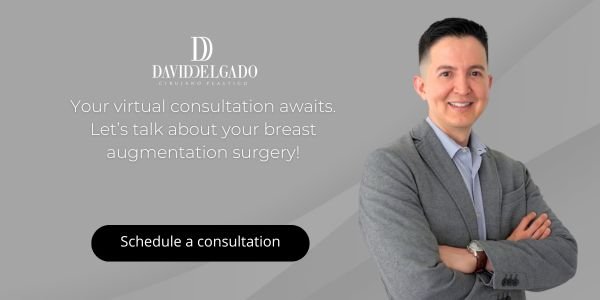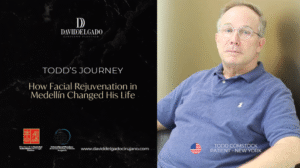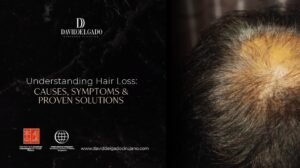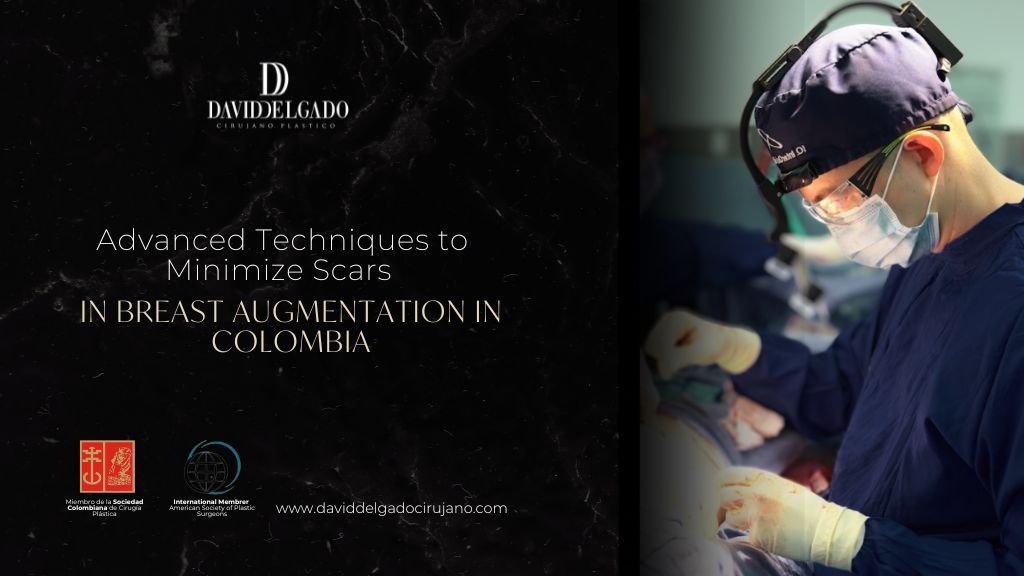
Are you worried about how the scars will look after your breast augmentation? I’m so glad you’re here, because this is a very common concern. I’m Dr. David Delgado, a plastic surgeon based in Medellín, and I completely understand your worries—it’s something I talk about with my patients all the time. The good news is that with the right technique and proper care, scars don’t have to be a problem.
If you’re considering breast augmentation, it’s completely natural to want to know everything about the process, including how scars will be handled. In this blog, I’ll explain the different types of scars, what factors affect their appearance, and how I can help minimize their visibility, so you can feel amazing with your new body. And if you’re thinking about having a breast augmentation, I invite you to consider Colombia as a great destination for it.
Feel free to reach out to me if you’re ready to take the next step toward your dream look.
What are breast implant scars?
When people think about scars after breast augmentation, they often imagine large, visible marks. However, the reality is that scarring depends on several factors. Scars are a natural part of the healing process that occurs after the skin is cut to place the breast implants.
During surgery, I make an incision in the skin to insert the breast implant, either under or over the muscle. After the surgery, your body starts healing, which leads to the formation of a scar. This is a normal part of the recovery process. But the good news is that the appearance of the scar doesn’t have to be something you fear.
Why do breast implant scars vary from one woman to another?
Scars can look different depending on various factors. For example, the surgical technique we use, such as the placement of the incision, plays a major role in how the scar will appear. If the incision is made carefully in a strategic area—like the natural crease under the breast—the scar will be much less noticeable.
A certified plastic surgeon in Columbia must complete:
Factors that affect the healing of breast implant scars
While the type of incision and the surgeon’s skill are crucial, there are also other factors that influence how the scar will look once it’s healed. Here are some of them:
Your skin type
Some women have skin that’s more prone to forming thick or hypertrophic scars, while others tend to form softer, less noticeable scars.
Post-operative care
This is where I come in to help. Following post-surgery instructions is key to ensuring the best possible scar healing. Avoiding sun exposure, using the recommended creams, and keeping the area clean are essential steps to take care of your scar.
Implant placemen
If larger implants are used or if a longer incision is necessary, the scar may be a bit more visible. However, with precise techniques, I always aim to place the scar in the most discreet area and make it as small as possible.
What to expect from your breast augmentation scars
With the right technique and proper care, breast augmentation scars typically fade over time, and in many cases, they become barely noticeable. After a few months, most of my patients are extremely satisfied with the final result. In my practice, I always make it a priority to place incisions in a way that makes them as discreet as possible, ensuring that your aesthetic recovery is the best it can be.
Types of breast implant scars and what makes them different
When it comes to breast augmentation scars, it’s important to understand that every body and every case is unique. As I mentioned earlier, scars can vary depending on several factors, but what I can assure you is that with the right technique, what you’ll notice most will be your transformation, not the scar. Here’s an overview of the different types of scars you might have and what makes them distinct:
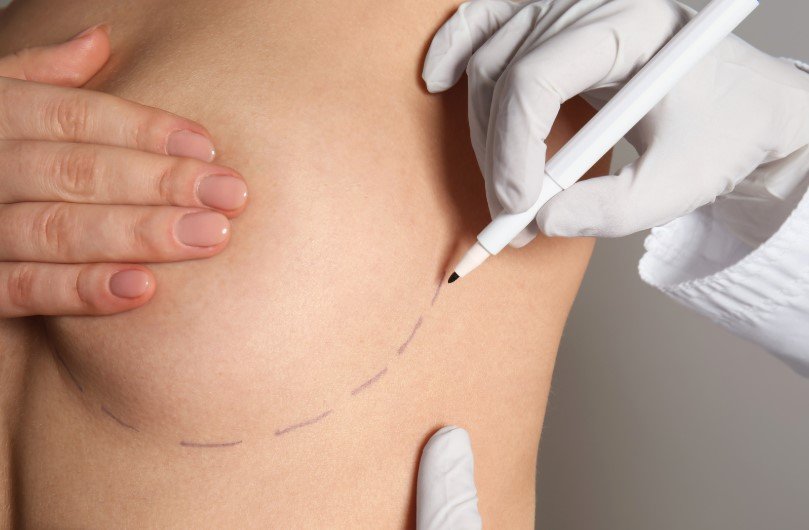
Inframammary scar: The most common and discreet
The inframammary scar is the most commonly used and generally the easiest to hide. It’s placed right in the natural fold at the bottom of the breast, which makes it nearly invisible as it heals. The great advantage of this incision is that it stays perfectly concealed, even once the skin has fully recovered.
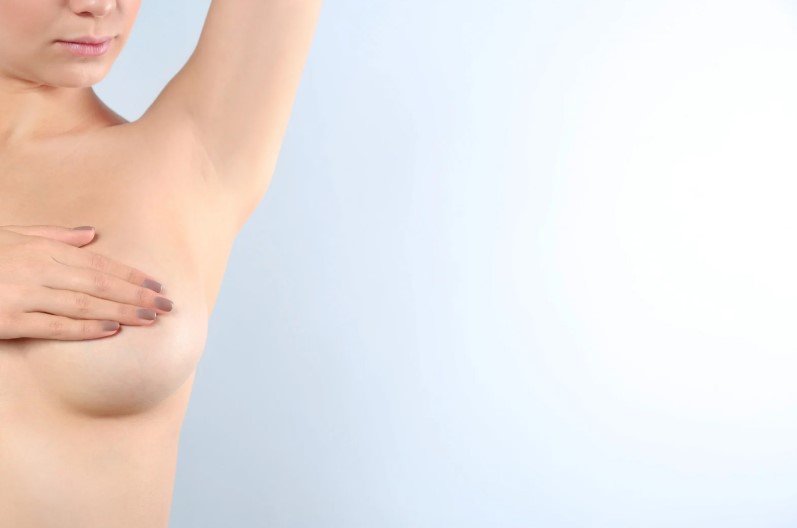
Periareolar scar: Around the areola
If you prefer the scar to be in a less noticeable area, the periareolar scar might be the best option for you. This incision is made around the areola (the darker ring around the nipple), which helps to camouflage it. While less visible, in some patients, the areola may be small, and the scar could be a bit more noticeable.

Transaxillary scar: No scars on the breast
For those who want to avoid any visible scars on the breast itself, the transaxillary scar is an option. This incision is made in the armpit, leaving no mark on the breast. However, it’s a slightly more complex technique and may require greater skill to achieve the best results. Recovery might also be a bit more uncomfortable in this area.

Inframammary scar in an inverted T or anchor shape
This type of scar is used when a breast lift (mastopexy) is combined with augmentation. The inverted T or anchor-shaped scar runs along the breast fold and up around the areola. While more visible, it’s necessary in some cases to achieve a firmer and more natural-looking shape.
What affects the appearance of breast augmentation scars?
As I mentioned before, the final result depends a lot on how the surgery is performed and how closely you follow the post-operative care. Here are some key factors that can influence the appearance of your scars:
Surgical technique
The precision of the incision is crucial to ensure the scar is as small and discreet as possible. I always aim to place incisions in areas where they can be easily hidden and blend in naturally.
Your skin type
Every patient heals differently. Some people tend to form thicker or raised scars, while others develop softer, less noticeable ones. If you’re concerned about how your skin might affect scarring, we’ll discuss it during your consultation to make sure you’re fully informed.
Post-operative care
Proper follow-up after the surgery is essential. I will provide you with clear instructions on how to care for the area to make sure the scar heals in the most discreet way possible.
Implant size and type
In some cases, larger implants may require a longer incision. However, my goal is always to make sure that the scars are as discreet as possible, no matter the type or size of the implant.
How to reduce and manage scars after breast augmentation
Follow Post-Operative Instructions to the Letter
It’s essential to follow all post-operative instructions to ensure proper healing. Avoid physical exertion during the first few days and wear the recommended surgical bra to keep the implants in place.
Use Scar Creams
I recommend using creams or gels that contain silicone, vitamin E, or aloe vera. These products help soften and flatten scars, improving their appearance over time.
Consider Laser Treatments
If needed, after several months, we can explore laser treatments to help reduce any prominent scars. These treatments help smooth the texture and even out the skin tone.
Avoid Sun Exposure on the Scars
Sun exposure can darken scars, so it’s important to protect them from direct sunlight during the first few months. If you need to go outside, always apply a high SPF sunscreen (SPF 50+).
Perform Gentle Massages
Once the scars have begun to heal, gently massage them to improve circulation and help reduce the formation of thick scar tissue. Always use an appropriate cream, and be careful not to apply too much pressure.
Discreet Incision Techniques
As a plastic surgeon, I focus on making precise, discreet incisions, utilizing the natural folds of the skin to minimize scar visibility. With the proper care, these scars will blend seamlessly with the rest of your skin.
The Importance of precise surgical technique for minimal scarring in breast sugmentation
When it comes to reducing the visibility of scars after a breast augmentation, the surgical technique is key. My approach focuses on making precise, strategic incisions, always taking advantage of the natural folds in the skin, such as the inframammary fold or around the areola. This not only enhances the overall aesthetic result but also ensures that the scars are as discreet as possible. With my experience, I can guarantee that paying attention to every detail is what truly makes the difference in your aesthetic recovery.
Schedule your virtual consultation for a boob job in Colombia
If you have any questions about the procedure, the scars, or any aspect of the surgery, I invite you to schedule a virtual consultation with me. During our consultation, we can address all your concerns and guide you through every step of the process, so you feel completely confident before making your decision. I’m here to help!
Frequently Asked Questions about Breast Implant Scars
How can I minimize breast implant scars?
Breast implant scars can be minimized significantly with proper care. Following post-operative instructions carefully is essential, such as avoiding sun exposure and using the recommended creams. Additionally, using precise surgical techniques, like incisions in natural skin folds (such as the inframammary fold or around the areola), helps reduce their visibility.
How long does it take for breast implant scars to fade?
Scar healing time varies from person to person, but generally, breast implant scars begin to improve within a few months and can fade completely after a year. With proper care and specialized surgical techniques, scars tend to be minimal and less noticeable over time.
Are breast implant scars permanent?
Yes, breast implant scars are permanent, but with proper care, they can become minimal and barely visible. With the right surgical technique and placement of incisions in discreet areas like the inframammary fold, the scars tend to blend in seamlessly with the skin as they heal.
What factors affect the appearance of breast implant scars?
The appearance of breast implant scars depends on several factors: the surgical technique used, the patient’s skin type, the surgeon’s skill, and how the scars are cared for post-surgery. Proper post-operative care, like avoiding sun exposure and following medical instructions, also plays a significant role in healing.
Can I have breast augmentation without visible scars?
While it’s impossible to completely eliminate scars from breast augmentation, advanced surgical techniques can make them as discreet as possible. By placing incisions in natural folds, like the inframammary fold or around the areola, the scars can be minimized and made less noticeable.
What types of scars can I expect with breast implants?
There are several types of breast implant scars depending on the technique used. The most common include the inframammary scar (under the breast fold), the periareolar scar (around the areola), and the transaxillary scar (in the armpit). Each type has its advantages and disadvantages, but with the right technique, all can result in minimal, discreet scars.
Can I treat breast implant scars with laser treatments?
Yes, after a few months, if the breast implant scars are more prominent, laser treatments can be considered to improve their appearance. Laser treatments help smooth the texture of the scar and even out skin tone, reducing its visibility.
Why do breast implant scars vary from one woman to another?
Breast implant scars vary due to factors like skin type, surgical technique, and how each patient’s body heals. Some people tend to form thicker or raised scars (hypertrophic scars), while others develop softer, less noticeable scars.
Is it possible to avoid scars completely in breast augmentation?
It’s not possible to avoid scars completely in breast augmentation, as surgery involves an incision in the skin. However, with the right technique, post-operative care, and strategic placement of the incision, scars can be minimal and nearly invisible once healed.
What can I do to ensure my breast implant scars heal well?
To ensure good healing and minimize the visibility of breast implant scars, it’s important to follow all your surgeon’s instructions. This includes wearing the recommended surgical bra, avoiding sun exposure, using scar creams like silicone gel, and gently massaging the scars once they have healed sufficiently.


